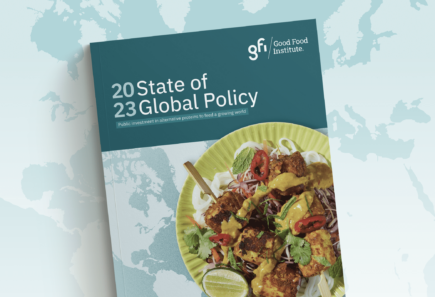
Alternative proteins public investment database
Explore public investments in alternative protein science and commercialization from governments around the world.
Discover how governments invest in alternative proteins to enhance their security, prosperity, and resiliency
Governments around the world are investing in new food technologies to support economic development, environmental security, and technological advancement. This database includes publicly-known investments by governments to advance the science and commercialization of alternative proteins, including research grants and calls, business development grants and vouchers, investments from public entities and sovereign wealth funds, loans and loan guarantees, multi-year funding commitments and appropriations, and other forms of government investment.
Notes on methodology
This database tracks government announcements by the dollar value of announced funding (“Funding Estimate”). While the database separately tracks the estimated disbursement of funds by year by dividing the total amount of funding by the duration of the project or program (if known), the funding estimate includes both past spent funding and future committed funding unless otherwise noted.
Currency conversions to USD are calculated by the average exchange rate on the indicated date, typically the date of the announcement or the project’s start date, whichever is earlier (or whichever is known). If no dates are known, the conversion is calculated on the first day of the known month or year of the investment.
Loans, loan guarantees, dilutive investments, and other funding arrangements in which governments may expect complete, partial, or equity-derived reimbursement are nevertheless calculated as the full monetary value of the loan or loan guarantee. These types of funding arrangements provide both tangible and intangible value to the alternative protein ecosystem even when eventually recouped by funders. Governments also often set aside the entire amount of a loan guarantee while the funding arrangement is active, representing a temporary government outlay even when no transaction ultimately takes place.
The Good Food Institute is not a licensed investment or financial advisor, and nothing in this resource is intended or should be construed as investment advice. This database is not intended to provide comprehensive reporting on all government actions on alternative proteins, but serves as a resource to browse publicly-disclosed investments. Where specific funding amounts are not known, GFI estimates the amount invested in alternative proteins by governments using the best public information available and consistent internal guidelines. All figures should be considered estimates made by GFI unless supported by the cited government resources (“Source”). The combined entries in this database may not match figures presented in GFI’s State of Global Policy Report, as those latter figures include information known to GFI but not included in this resource. Where in conflict, insights from the State of Global Policy Report take precedence.
This database is regularly updated, but we encourage crowdsourced contributions to ensure that it is as accurate and comprehensive as possible. If you know of any investments or other information missing from this database, please reach out to Michael Carter.
Related resources

The State of Global Policy on Alternative Proteins
Our annual State of Global Policy Report tracks public investment in alternative proteins and showcases the actions governments took to position themselves as leaders in the field.

Research grants tracker
Explore data on funded alternative protein research grants from around the world to discover insights using our dashboard or our database.

Alternative protein company database
Explore the landscape of plant-based, cultivated, and fermentation companies including consumer brands, manufacturers, and ingredients companies.
